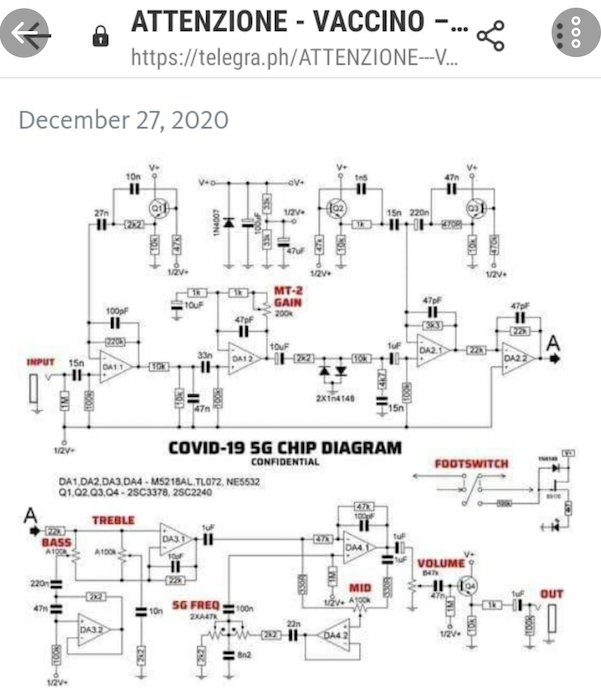I felt it important to press the pause button (yes, after only three posts) and unpack my motivation for beginning to write about the world of Customer Success (CS). This will hopefully lay the foundation for future posts and will provide some context for the thoughts I expressed in the last three articles.
Did you hear about the guitar-pedal-covid-vaccine hoax? Reports are that it began in Italy. Conspiracy theorists started posting the following image, claiming it was a schematic representing how a 5G chip was being inserted into COVID vaccines, thereby giving governments the ability to track and control all those that received the vaccine.

It turns out the schematic was actually that of a BOSS MT-2 Metal Zone guitar pedal.
I think the BOSS MT-2 schematic represents something else…the current state of Customer Success in the SaaS world.
You get a thought leader! You get a thought leader! And you get a thought leader!
If you buy into the history of Customer Success as presented by the Customer Success Association1, and I see no reason not to, you will read that Customer Success was born in 1996 at a company called Vantive by Marie Alexander. The goal of Marie’s new team was quite simple:
This is the Customer Success team that’s going to ensure that you’re successful in using Vantive. And their compensation is based on your success.
While not every Vantive customer was assigned a Customer Success Manager, the process began with the question: “How are you going to define your success? What do you expect from us?” The next step was to document those expectations in the Vantive system, and to introduce the Customer Success Manager who would work with the customer towards realizing them. At the six-month point, that list of expectations would be sent back to the customer, and a review meeting was scheduled. The CS team asked if the customer felt that they had been successful. If there were any concerns, the matter would be explored and the expectations appropriately re-set for the next six-month period.
Notice what is lacking in this description: churn rate, renewal rate, QBR’s, EBR’s, expansion opportunities, up-sell, cross-sell, opportunity management. The list could go on, but the point remains -Marie was laser focused. Twenty-five years later we have turned CS and the role of the CSM into something it was never intended to be or do. And because we are unable to disconnect the capitalist wiring in our brains, we have commoditized CS in much the same way we did with “DevOps”. My fear is that we will be met with the same results.
If you are unfamiliar with “DevOps” here is a quick summary: around 2007 the increasing siloed work and dysfunction found within SaaS organizations became hot news. That is, teams of developers and operations teams felt isolated from one another and started voicing their concerns with this ongoing isolation. A problem was born, or at least in this case, identified, and an entire market has grown up around trying to solve the silo issue and get developers and operators to work better (i.e. more efficient) together. Thirteen years later we are still talking about DevOps and “solving the problem”. Few shops do it well. We’ve had hundreds of thought leaders wax poetic about how DevOps can be done correctly, but we hear few success stories.
Even this past week I came across the following tweet (emphasis mine):
FWIW, I interviewed a dozen modern SaaS companies running production k8s clusters last year. Many names you know including Postmates. None of them have “true DevOps”.
DevOps did not manifest as we expected. Trying to push the ideal is probably self-defeating at this point.
Randy Bias
Pushing the ideal is probably self-defeating at this point.
Randy’s thread goes on to state, “But amongst the dozen companies I talked to none of them had people crossing lines. Devs were far too busy delivering new features and operators were far too busy dealing with production issues.”
Therein lies the rub…DevOps is great in theory, but really difficult to implement with success. I fear that is what we are doing to Customer Success. We are making it too difficult for CS teams to be successful. You might ask what my definition of success is? Fair question. It is the same as Marie Alexander at Vantive. For a CS team to be successful, their customers must be successful. How do you know if your customers are successful? Simple, they are solving real business problems with your software, and you are helping them.
Reducing churn is not a measure of your CS teams success. Neither is a renewal rate above 100%. Neither is an increase in expansion opportunities. Neither is an NPS score of…well, any score. But for some reason these are the metrics we seem to care about, to measure, and to compensate around. I agree with Randy…trying to push the ideal (that this should be the focus of CS) is probably self-defeating at this point.
With that in mind, I will attempt to pull the curtain back and write about CS as simplistically as I can. I am far from a thought leader, but I am concerned that CS has become its own worst enemy. Given that CS is my career choice, I would rather not see it eat itself alive.
